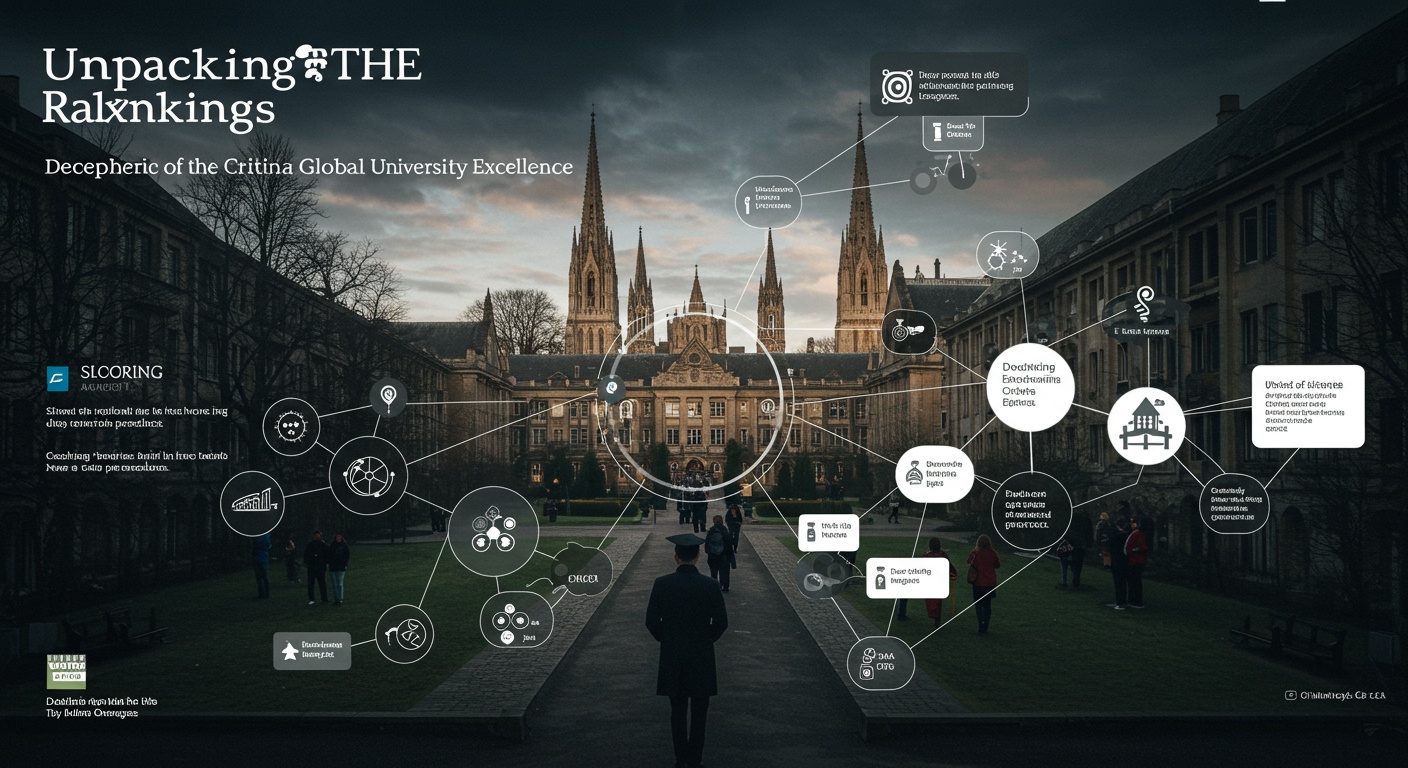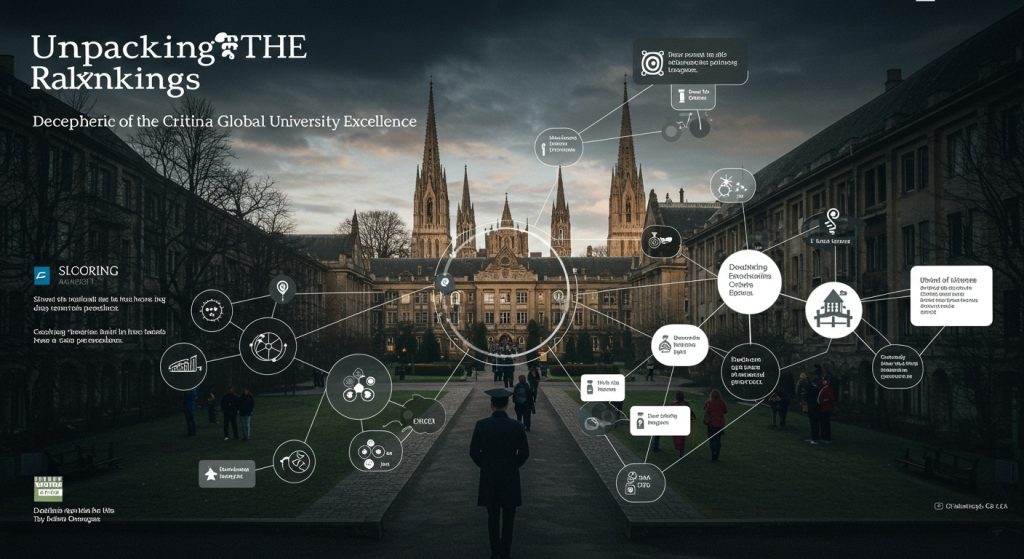Global university rankings, meticulously compiled by entities like QS and THE, annually reshape institutional prestige and influence student choice, yet their underlying methodologies remain a complex, often opaque, landscape. While traditional indicators such as research citations and academic reputation still hold significant weight, recent developments highlight a growing emphasis on metrics like sustainability performance, international collaboration. Graduate employability outcomes, reflecting broader societal priorities. Understanding how a 20% allocation for faculty-student ratio contrasts with a 30% weight for research output, or how specific surveys define “employer reputation,” reveals the strategic maneuvering universities undertake to ascend these competitive ladders. This exploration dissects the precise criteria – from publication volume and normalized citations to global partnerships and social impact – that ultimately determine a university’s standing in the fiercely contested arena of global academic excellence.

What Are “THE Rankings” Anyway?
When we talk about global university excellence, one name frequently comes up: the Times Higher Education (THE) World University Rankings. But what exactly are these “THE Rankings” and why do they hold so much sway in the academic world? At its core, THE Rankings are an annual publication that assesses and ranks universities across the globe, providing a comprehensive overview of their performance. They are one of the most widely recognized and influential global university rankings, alongside others like the QS World University Rankings and the Academic Ranking of World Universities (ARWU).
The concept of “University Rankings” itself is relatively modern, gaining significant traction in the early 21st century. Before this, evaluating universities was often a localized or anecdotal affair. These global rankings emerged to provide a standardized, data-driven method for comparing institutions across different countries and educational systems. For a general audience, understanding these rankings means understanding a powerful tool that shapes perceptions, influences decisions. Drives competition among the world’s leading academic institutions.
The Pillars of Excellence: Core Criteria Explained
The Times Higher Education (THE) World University Rankings employ a robust methodology built upon 18 carefully calibrated performance indicators, grouped into five key pillars. Each pillar contributes a specific percentage to a university’s overall score, reflecting what THE believes are the most crucial aspects of a world-class institution. Let’s break down these pillars:
- Teaching (Learning Environment) – 29. 5%
- This pillar assesses the quality of a university’s learning environment. It considers a range of metrics including:
- Reputation Survey (15%): Based on an annual academic reputation survey that asks leading academics to identify the best universities for teaching in their field.
- Staff-to-Student Ratio (4. 5%): A measure of how many academic staff members there are per student, indicating the potential for personalized attention.
- Doctorate-to-Bachelor’s Ratio (2%): Reflects the proportion of research-intensive degrees being awarded, suggesting a robust research culture.
- Doctorates Awarded to Academic Staff Ratio (5. 5%): Measures the number of doctoral degrees awarded relative to the size of the academic staff, indicating the level of high-level research training.
- Institutional Income (2. 5%): Income per academic staff member, adjusted for purchasing power parity (PPP), indicating the resources available for teaching and research.
Why it matters: A strong teaching environment attracts top students and prepares them for future success. Universities often invest heavily in faculty development and smaller class sizes to boost these scores.
- Research (Volume, Income, Reputation) – 29. 0%
- This pillar evaluates a university’s research prowess.
- Reputation Survey (18%): Similar to the teaching survey, this asks academics to identify the best universities for research in their field.
- Research Income (5. 5%): The amount of research income a university attracts, normalized by the number of academic staff, reflecting its ability to secure competitive grants.
- Research Productivity (5. 5%): The number of papers published in reputable journals, normalized by the number of academic staff.
Why it matters: High-quality, impactful research is a hallmark of leading universities, driving innovation and knowledge creation.
- Citations (Research Influence) – 30. 0%
- This is arguably the most significant single indicator, measuring a university’s research influence.
- Field-weighted Citation Impact (30%): This metric counts the average number of times a university’s published work is cited by scholars globally. It’s “field-weighted” to account for different citation practices across academic disciplines (e. G. , medical research typically has higher citation rates than humanities).
Why it matters: High citation counts indicate that a university’s research is being widely recognized, built upon. Contributing significantly to global knowledge.
- International Outlook (Staff, Students, Research) – 7. 5%
- This pillar assesses a university’s ability to attract international talent and collaborate globally.
- Proportion of International Students (2. 5%)
- Proportion of International Staff (2. 5%)
- International Collaboration (2. 5%): The proportion of a university’s research publications that have at least one international co-author.
Why it matters: A diverse, international environment enriches the learning experience and fosters global perspectives and collaborations, which are crucial for addressing global challenges.
- Industry Income (Knowledge Transfer) – 4. 0%
- This pillar measures a university’s ability to help industry with innovations, inventions. Consultancy.
- Industry Income per Academic Staff (4%): Revenue from industry (adjusted for PPP) per academic staff member, indicating the extent to which businesses are willing to invest in and utilize a university’s research and expertise.
Why it matters: Strong links with industry demonstrate a university’s practical relevance and its contribution to economic growth and societal benefit through knowledge transfer.
These criteria are chosen because they collectively aim to provide a holistic view of a university’s performance, balancing teaching quality, research excellence, global integration. Real-world impact. For instance, a university might strategically invest in research infrastructure or international recruitment initiatives to boost its standing in specific areas of these University Rankings.
Beyond THE: A Glimpse at Other Major Players
While THE Rankings are incredibly influential, they are not the only game in town. Other prominent global University Rankings, each with its unique methodology and focus, offer different perspectives on university excellence. The two other major players are the QS World University Rankings and the Academic Ranking of World Universities (ARWU), also known as the Shanghai Ranking. Understanding their differences is crucial because a university’s position can vary significantly across these lists, reflecting the distinct values each ranking system prioritizes.
Here’s a comparison of the primary criteria and weightings for these three leading global University Rankings:
| Criterion | THE World University Rankings (Times Higher Education) | QS World University Rankings | ARWU (Shanghai Ranking) |
|---|---|---|---|
| Academic Reputation | Teaching (15%), Research (18%) – Total 33% | 40% | 20% (Alumni winning Nobel/Fields), 40% (Staff winning Nobel/Fields) – Total 60% |
| Employer Reputation | Not directly weighted | 10% | Not directly weighted |
| Citations/Research Influence | 30% (Field-weighted Citation Impact) | 20% (Citations per Faculty) | 20% (Highly Cited Researchers) |
| Faculty-Student Ratio | 4. 5% | 20% | Not directly weighted |
| Internationalization | 7. 5% (International Staff, Students, Co-authorship) | 10% (International Faculty, International Students) | Not directly weighted |
| Research Income | 5. 5% (per academic staff) | Not directly weighted | Not directly weighted |
| Industry Income / Knowledge Transfer | 4% | Not directly weighted | Not directly weighted |
| Alumni Awards / Nobel Prizes / Fields Medals | Not directly weighted | Not directly weighted | 20% |
| Highly Cited Researchers | Not directly weighted | Not directly weighted | 20% |
| Publications in Top Journals (Nature/Science) | Not directly weighted | Not directly weighted | 10% |
| Per Capita Academic Performance | Not directly weighted | Not directly weighted | 10% |
As you can see, the methodologies vary significantly. ARWU, for example, heavily emphasizes faculty and alumni winning prestigious awards like Nobel Prizes and Fields Medals, along with publications in top-tier journals. This often favors older, well-established research institutions with a long history of generating world-class scientific output. QS, on the other hand, places a significant emphasis on academic and employer reputation surveys, alongside a strong faculty-student ratio, which can benefit universities known for their teaching quality and graduate employability. THE strikes a balance, with substantial weight given to research reputation, citations. Teaching environment.
This divergence in methodology means that a university excelling in, say, producing Nobel laureates might rank higher in ARWU but perhaps lower in QS if its international student body isn’t as large or its employer reputation isn’t as strong. Conversely, a university with excellent teaching and strong industry links might do well in THE but not feature as prominently in ARWU. This highlights that “excellence” is defined differently by each ranking body. Understanding these nuances is key to interpreting their results.
The Ripple Effect: How Rankings Impact the Real World
University Rankings are far more than just lists; they have tangible, real-world impacts that ripple through various stakeholders – from prospective students and faculty to university administrators and even national governments. Their influence can shape strategic decisions, funding allocations. International partnerships.
- For Students: Navigating Choice and Boosting Prospects
For many prospective students, particularly those eyeing international education, University Rankings serve as an initial filter. A high ranking can signal prestige and quality, influencing where they apply. For instance, a student from India considering a Master’s degree in AI might prioritize universities consistently ranked in the top 50 by THE or QS, believing it will enhance their career prospects globally. While this provides a valuable starting point, it’s crucial for students to look beyond the headline number and delve into specific program rankings, faculty expertise, campus culture. Alumni networks relevant to their personal goals. A student interested in a niche field like forensic archaeology might find a top-tier program at a university not as highly ranked overall. Which offers superior specialization.
- For Universities: Strategy, Funding. Talent Acquisition
For university leadership, rankings are a constant point of discussion and strategic planning. A rise in the rankings can boost an institution’s reputation, making it more attractive to top-tier faculty and high-achieving students. This can, in turn, lead to increased research funding, as donors and government bodies often look to highly-ranked institutions as reliable partners for significant investments. For example, I once spoke with a university dean who shared how a significant jump in their ‘International Outlook’ score in THE rankings directly led to a surge in international student applications and a stronger position when applying for global research grants. They had strategically invested in recruiting international faculty and fostering international research collaborations specifically to improve this metric. It paid off.
Conversely, a drop in rankings can trigger internal reviews and pressure to implement changes. Universities might reallocate resources towards areas that contribute heavily to ranking scores, such as increasing research output, improving faculty-to-student ratios, or enhancing industry partnerships. This competitive drive can sometimes lead to what some critics call “gaming the system,” where universities might prioritize metrics over broader educational goals. It undeniably drives institutional self-improvement in the areas measured.
- For Governments and Policymakers: National Education Strategies
At a national level, governments often monitor the performance of their domestic universities in global rankings. A strong showing can be a source of national pride and an indicator of a country’s intellectual capital and research prowess. This can influence policy decisions related to higher education funding, research investment. Even immigration policies designed to attract top academic talent. Countries might implement national initiatives to boost their universities’ global standing, seeing it as vital for economic competitiveness and soft power. For instance, several Asian governments have poured significant funds into “world-class university” initiatives, directly aiming to improve their institutions’ positions in these global University Rankings.
In essence, University Rankings have become a powerful, albeit sometimes controversial, force in the global higher education landscape, influencing decisions from individual career paths to national strategic priorities.
Decoding the Nuances: Understanding the Limitations and Controversies
While global University Rankings offer valuable insights and have undeniable influence, it’s equally vital to approach them with a critical eye, recognizing their inherent limitations and the controversies they often spark. No single set of metrics can perfectly capture the multifaceted excellence of a university. Over-reliance on these rankings can lead to unintended consequences.
- Over-reliance on Quantitative Data
- Potential for “Gaming the System”
- Bias Towards STEM and English-Language Publications
- Exclusion of Specialized Institutions
- Lack of Context and Individual Fit
Rankings primarily rely on quantifiable data points like citation counts, research income. Student-to-staff ratios. While these are essential, they may not fully capture qualitative aspects such as teaching quality, student support services, campus culture, or the impact of a university’s work on local communities. For instance, a university might have an exceptional undergraduate teaching program. If its faculty aren’t publishing heavily in international journals, or if its research isn’t highly cited, its overall ranking might not reflect its teaching excellence. As Professor Simon Marginson, a leading expert on higher education from the University of Oxford, often points out, “Rankings are good at measuring research. They are very poor at measuring teaching.”
Because rankings have such high stakes, universities can be tempted to focus their efforts and resources on improving specific metrics rather than on holistic academic development. This could mean incentivizing faculty to publish more, even if quality suffers, or prioritizing international student recruitment solely for diversity scores without ensuring adequate support services. Some institutions might even engage in practices like encouraging self-citation or creating large numbers of low-value publications to inflate their scores in certain areas. This isn’t to say universities are disingenuous. The pressure to perform in these University Rankings is immense. It can lead to strategic decisions that optimize for metrics.
The heavy weighting given to research citations often inherently favors institutions with strong STEM (Science, Technology, Engineering. Mathematics) departments. Publications in these fields tend to have higher citation rates and are more frequently published in English, which is the dominant language in major citation databases. This can disadvantage universities strong in humanities, arts, or social sciences, or those where research is primarily published in other languages. A leading university in, say, Latin American literature might be world-renowned in its field but struggle to compete in citation-based metrics against a university strong in biomedical research.
General University Rankings often struggle to fairly assess highly specialized institutions, such as arts conservatories, medical schools that are not part of larger universities, or military academies. These institutions excel in very specific areas but may not have the broad research output or diverse student body that general rankings prioritize.
A high ranking doesn’t necessarily mean a university is the “best” fit for every individual. Factors like specific program offerings, campus location, student-faculty interaction style, research opportunities in a niche area, or even the cost of attendance are often far more relevant to a student’s personal and academic success than a global ranking number. For example, a student passionate about marine biology might find a smaller, coastal university with dedicated research facilities to be a far better fit than a highly-ranked urban university without such specialized resources.
Ultimately, while University Rankings provide a standardized snapshot, they should be viewed as one piece of a much larger puzzle. They are a tool for comparison, not the definitive word on institutional quality or individual suitability. Critical engagement with their methodology and a broader consideration of personal and academic needs are essential for making informed decisions.
Empowering Your Choice: Actionable Takeaways for Prospective Students and Researchers
Understanding the intricacies of global University Rankings, including their strengths and limitations, empowers you to make more informed decisions. Whether you’re a prospective student choosing a university, a researcher seeking a new affiliation, or simply someone interested in higher education trends, here are some actionable takeaways:
- Do Your Homework Beyond the Number
- Align with Your Priorities
- Investigate Specific Program Strengths
- Consider the “Fit” Factors
- Look at Multiple Sources
- Engage with the University Directly
Never rely solely on a university’s overall ranking. Use it as a starting point, a broad indicator of global standing. Then, dive deeper. Explore individual subject rankings (e. G. , “THE World University Rankings by Subject”) if available, as a university might be strong overall but exceptional in your specific field of interest, or vice versa. Many universities that don’t crack the top 100 globally still offer world-class programs in specific disciplines.
Reflect on what truly matters to you. Are you seeking a research-heavy environment with Nobel laureates? Then ARWU might be more relevant. Are you looking for a strong international community and good job prospects? QS or THE might offer more insights. Is teaching quality paramount? Look for metrics like student-to-faculty ratios and teaching reputation surveys, which are often embedded within the larger ranking systems or available directly from universities.
A university’s overall ranking doesn’t always reflect the strength of a particular department or program. A university ranked #200 globally might have a top-10 program in computer science or a unique, highly specialized research lab that perfectly aligns with your interests. Look at faculty profiles, research output from specific departments. Course curricula.
Beyond academic metrics, consider the qualitative aspects that impact your experience. Think about campus culture, location, student life, career services, alumni network, scholarship opportunities. The overall learning environment. These “fit” factors often contribute more to your personal and professional development than a numerical rank. For example, a student who thrives in a small, intimate learning environment might be overwhelmed by a massive research institution, regardless of its ranking.
Just as you wouldn’t rely on a single news source, don’t rely on a single ranking system. Compare THE, QS. ARWU. See if a university consistently performs well across different methodologies, or if its strengths are more aligned with one particular ranking’s focus. This multi-faceted view provides a more balanced perspective.
Visit campuses (if possible), attend virtual open days, talk to current students and alumni. Reach out to department faculty. Direct engagement will give you a feel for the institution that no ranking can provide. Ask specific questions about student support, career outcomes for your chosen program. Research opportunities.
By taking a nuanced, informed. Critical approach to University Rankings, you can leverage them as a helpful guide rather than a definitive judgment, ultimately making a choice that best serves your unique educational and career aspirations.
Conclusion
Ultimately, global university rankings, from QS to THE and ARWU, serve as valuable snapshots, reflecting institutional strengths primarily in research output, academic reputation. Internationalization. But, they are not the sole arbiters of quality or fit. It’s crucial to grasp that while a university’s standing can indicate prestige, it doesn’t always reflect program-specific excellence or alignment with your personal aspirations. For instance, a highly-ranked research institution might not be ideal if you prioritize hands-on experiential learning, a trend increasingly valued by employers. I recall how focusing beyond the top-tier lists led me to a specialized program perfectly suited for my niche career path, which wouldn’t have been apparent from general rankings alone. Therefore, your actionable takeaway is to leverage rankings as a starting point, not a definitive guide. Dive deeper into departmental strengths, faculty research, campus culture. Crucially, explore how a university aligns with future education trends focusing on skills and practical application. Don’t be swayed solely by a number; instead, empower yourself by understanding the criteria and seeking a holistic fit. Your optimal university experience will be one that truly fuels your unique potential, regardless of its global rank. For more insights into future educational pathways, consider exploring resources on the evolving landscape of university curricula.
More Articles
Ensuring Quality Education: Understanding Accreditation and Standards for University Programs
Beyond the Classroom: Uncovering Experiential Learning Opportunities at Public Universities
Top Undergraduate Programs: Exploring Popular Courses and Degrees at State Universities
Direct vs Regular: A Balanced Comparison of University Admission Routes
The Future of Learning: Key Trends Shaping Public University Curricula by 2025
FAQs
What exactly are ‘THE Rankings’ we’re talking about?
‘THE Rankings’ stands for the Times Higher Education World University Rankings. It’s one of the most widely recognized global assessments that evaluates universities on various aspects of their performance.
Why bother looking at university rankings in the first place?
They offer a valuable snapshot of a university’s global standing and strengths. For students, they can help narrow down choices; for institutions, they provide benchmarks; and for governments, they inform policy decisions about higher education.
What are the main things they look at to decide who’s top-tier?
THE Rankings use several key indicators: teaching environment, research volume, income. Reputation, citations (how much a university’s research is cited by others), industry income (knowledge transfer). International outlook (staff, students. Research collaborations).
Do all university ranking systems use the same secret formula?
Not at all! While there’s some overlap, different ranking systems (like QS or ARWU) have their own methodologies and weighting for criteria. This is why a university might rank differently across various lists.
Can a university actually get better at these rankings, or are they pretty fixed?
Universities actively work to improve their standing. They might focus on enhancing research output and impact, attracting top faculty, boosting international partnerships, or investing in student experience to climb the ranks.
Are these rankings totally perfect and unbiased?
While comprehensive, no ranking system is flawless. They can have limitations like data availability, potential biases, or not fully capturing a university’s unique culture, specialized programs, or true student fit, which are often subjective.
What does ‘global university excellence’ mean when it comes to these rankings?
In this context, ‘global university excellence’ refers to a university performing exceptionally well across the specific metrics used by THE Rankings. It signifies strength in areas like world-class teaching, groundbreaking research, impactful innovation. A strong international presence.



